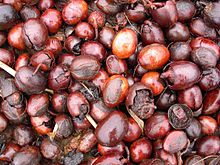Vitellaria
| Vitellaria | |
|---|---|

| |
| Shea nuts | |
| Scientific classification | |
| Kingdom: | |
| (unranked): | |
| (unranked): | |
| (unranked): | |
| Order: | |
| Family: | |
| Genus: | |
| Species: | B. parkii
|
| Binomial name | |
| Butyrospermum parkii | |
| Synonyms | |
|
Butyrospermum paradoxa Vitellaria paradoxa | |
Butyrospermum parkii or Vitellaria paradoxa, commonly known as shea tree, vitellaria or karité, is a tree indigenous to Africa, occurring in Mali, Cameroon, Congo, Côte d'Ivoire, Ghana, Guinea, Togo, Nigeria, Senegal, Sudan, Burkina Faso and Uganda. The shea fruit consists of a thin, tart, nutritious pulp that surrounds a relatively large, oil-rich seed from which is extracted shea butter.
The shea tree is a traditional food plant in Africa. It has been claimed that that the tree has potential to improve nutrition, boost food security, foster rural development and support sustainable landcare.[1]
Characteristics
The tree is perennial and starts bearing the first fruits when it is 10–15 years old; full bearing is attained when the tree is about 20–30 years. It produces nuts for up to 200 years after reaching maturity.
The fruits resemble large plums and take 4–6 months to ripen. Average yield is 15–20 kilograms of fresh fruit per tree, with optimum yields up to 45 kg. Each kilogram of fruit gives approximately 400 grams of dry seeds.
Distribution

The shea tree grows naturally in the wild in the dry savannah belt of West Africa from Senegal in the west to Sudan in the east, and onto the foothills of the Ethiopian highlands. It occurs in 19 countries across the African continent, namely Benin, Burkina Faso, Cameroon, Central African Republic, Chad, Ethiopia, Ghana, Guinea Bissau, Côte d'Ivoire, Mali, Niger, Nigeria, Senegal, Sierra Leone, Sudan, Togo, Uganda, Democratic Republic of the Congo and Guinea.
A reflection of its extensive range of occurrence nearly 5,000 km from Senegal (west) to Uganda (east) across the African continent.
The shea tree grows in Northern West Africa, over about 77,670 square kilometers in Western Dagomba, Southern Mamprusi, Western Gonja, Lawra, Tumu, Wa and Nanumba with Eastern Gonja having the densest stands. There is sparse shea tree cover found in Brong Ahafo, Ashanti, and the Eastern and Volta regions in the south of the country.
In the Guinea savannah the plant can thrive abundantly also in the Sudan.
Uses
Shea nut "butter" has many uses and may or may not be refined. In the West, shea butter is mostly used for cosmetics. Throughout Africa it is used extensively for food and medicinal purposes, and is a major source of dietary fat.
Etymology
The common name is sí yiri ("shea tree") in the Bamana languages of Mali. This is the origin of the English word, and is correctly pronounced "shee" to rhyme with "tea". The tree is called ghariti in the Wolof language of Senegal, which is the origin of the French name of the tree (and of its butter), karité.
The tree was formerly classified in the genus Butyrospermum, meaning "butter seed". The species name parkii honors Mungo Park, who learned of the tree while exploring Senegal). The tree has been known also by the alternate binomial name Vitellaria paradoxa, which is the current official designtion.
References
- ^ National Research Council (2006-10-27). "Shea". Lost Crops of Africa: Volume II: Vegetables. Lost Crops of Africa. Vol. 2. National Academies Press. ISBN 978-0-309-10333-6. Retrieved 2008-07-15.
{{cite book}}: Cite has empty unknown parameter:|origdate=(help); External link in|chapterurl=|chapterurl=ignored (|chapter-url=suggested) (help)
External links
- Vitellaria paradoxa in Brunken, U., Schmidt, M., Dressler, S., Janssen, T., Thombiano, A. & Zizka, G. 2008. West African plants - A Photo Guide. Forschungsinstitut Senckenberg, Frankfurt/Main.

